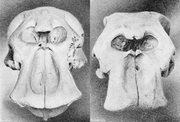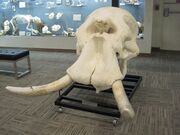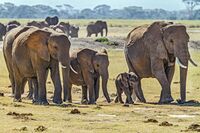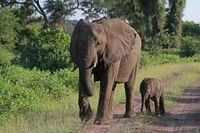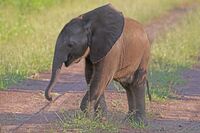Biology:African bush elephant
| African bush elephant | |
|---|---|
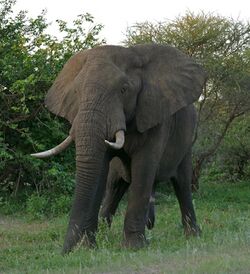
| |
| Male in Kruger National Park, South Africa | |
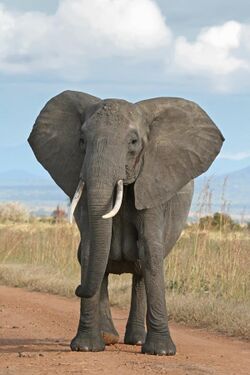
| |
| Female in Mikumi National Park, Tanzania | |
| Scientific classification | |
| Domain: | Eukaryota |
| Kingdom: | Animalia |
| Phylum: | Chordata |
| Class: | Mammalia |
| Order: | Proboscidea |
| Family: | Elephantidae |
| Genus: | Loxodonta |
| Species: | L. africana[1]
|
| Binomial name | |
| Loxodonta africana[1] (Blumenbach, 1797)
| |
| Subspecies | |
|
See text | |
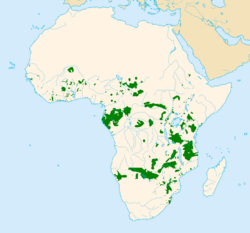
| |
| Distribution of Loxodonta (2007) | |
| Synonyms | |
|
Elephas africanus | |
The African bush elephant (Loxodonta africana), also known as the African savanna elephant, is the largest living terrestrial animal with bulls reaching a shoulder height of up to 3.96 m (13.0 ft). Both sexes have tusks, which erupt when they are 1–3 years old and grow throughout life.[3][4]
It is distributed across 37 African countries and inhabits forests, grasslands and woodlands, wetlands and agricultural land. Since 2004, it has been listed as Vulnerable on the IUCN Red List. It is threatened foremost by habitat destruction, and in parts of its range also by poaching for meat and ivory.[2] It is a social mammal, traveling in herds composed of cows and their offspring. Adult bulls usually live alone or in small bachelor groups. It is a herbivore, feeding on grasses, creepers, herbs, leaves and bark.
Taxonomy
Elephas africanus was the scientific name proposed by Johann Friedrich Blumenbach in 1797.[5] Loxodonte was proposed as generic name for African elephants by Georges Cuvier in 1824. This name refers to the lozenge-shaped enamel of the molar teeth, which differs significantly from the shape of the Asian elephant's molar enamel.[6]
In the 19th and 20th centuries, several zoological specimens were described by naturalists and curators of natural history museums from various parts of Africa, including:
- Elephas (Loxodonta) oxyotis and Elephas (Loxodonta) knochenhaueri by Paul Matschie in 1900. The first was a specimen from the upper Atbara River in northern Ethiopia, and the second a specimen from the Kilwa area in Tanzania.[7]
- Elephas africanus toxotis, selousi, peeli, cavendishi, orleansi and rothschildi by Richard Lydekker in 1907 who assumed that ear size is a distinguishing character for a race. These specimens were shot in South Africa, Mashonaland in Zimbabwe, Aberdare Mountains and Lake Turkana area in Kenya, in Somaliland and in western Sudan, respectively.[8]
- North African elephant (L. a. pharaohensis) by Paulus Edward Pieris Deraniyagala in 1948 was a specimen from Fayum in Egypt.[9]
Today, these names are all considered synonyms.[1]
Phylogeny
A genetic study based on mitogenomic analysis revealed that the African and Asian elephant genetically diverged about 7.6 million years ago.[10] Phylogenetic analysis of nuclear DNA of African bush and forest elephants, Asian elephant, woolly mammoth and American mastodon revealed that the African bush elephant and the African forest elephant form a sister group that genetically diverged at least 1.9 million years ago. They are therefore considered distinct species. Gene flow between the two species however, might have occurred after the split.[11]
-
Skulls of African bush elephant (left) and African forest elephant (right)
-
Skull of a male African bush elephant on display at the Museum of Osteology, Oklahoma City
-
Skeleton of a female African bush elephant on display at the Museum of Osteology, Oklahoma City
Characteristics
Skin and ears

The African bush elephant has grey skin with scanty hairs. Its large ears cover the whole shoulder.[12] They can grow as large as 2 m × 1.5 m (6.6 ft × 4.9 ft).[13] Large ears help to reduce body heat; flapping them creates air currents and exposes the ears' inner sides where large blood vessels increase heat loss during hot weather.[14] The African bush elephant's ears are pointed and triangular shaped. Its occipital plane slopes forward. Its back is shaped markedly concave. Its sturdy tusks are curved out and point forward.[15]
Size

The African bush elephant is the largest and heaviest land animal on Earth, with a maximum recorded shoulder height of an adult bull of 4.00 m (13.1 ft) and an estimated weight of up to 10.6 t (11.7 short tons). On average, males are about 3.20 m (10.5 ft) tall at the shoulder and weigh 6.00 t (6.61 short tons), while females are much smaller at about 2.60 m (8.53 ft) tall at the shoulder and 3.00 t (3.31 short tons) in weight.[4][16][17][18] Elephants attain their maximum stature when they complete the fusion of long-bone epiphyses, occurring in males around the age of 40 and females around the age of 25.[4]
Trunk
The trunk is a prehensile elongation of its upper lip and nose. Short tactile hair grows on the trunk, which has two finger-like processes on the tip.[19] This highly sensitive organ is innervated primarily by the trigeminal nerve, and thought to be manipulated by about 40–60,000 muscles. Because of this muscular structure, the trunk is so strong that elephants can use it for lifting about 3% of their own body weight. They use it for smelling, touching, feeding, drinking, dusting, producing sounds, loading, defending and attacking.[14] Functional loss of the trunk due to flaccid trunk paralysis sometimes makes the elephant carry the trunk over the tusk and walk into deep water in order to drink.[20]
Tusks
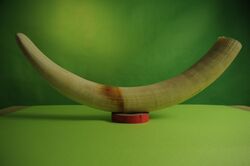
The tusks grow from deciduous teeth known as tushes that develop in the upper jaw and consist of a crown, root and pulpal cavity, which are completely formed soon after birth. Tushes reach a length of 5 cm (2 in).[21] The tusks erupt when elephants are 1–3 years old and grow throughout life.[3] They are composed of dentin and coated with a thin layer of cementum. Their tips bear a conical layer of enamel that is usually worn off when the elephant is five years old.[22] Tusks of bulls grow faster than tusks of females. Mean weight of tusks at the age of 60 years is 109 kg (240 lb) in bulls, and 17.7 kg (39.0 lb) in cows.[3] The longest known tusk of an African bush elephant measured 3.51 m (11.5 ft) and weighed 117 kg (258 lb).[23]
Molars
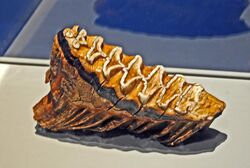
The dental formula of the African bush elephant is 1.0.3.30.0.3.3 × 2 = 26. It develops six molars in each jaw quadrant that erupt at different ages and differ in size.[3] The first molars grow to a size of 2 cm (0.79 in) wide by 4 cm (1.6 in) long, are worn by the age of one year and lost by the age of about 2.5 years. The second molars start protruding at the age of about six months, grow to a size of 4 cm (1.6 in) wide by 7 cm (2.8 in) long and are lost by the age of 6–7 years. The third molars protrude at the age of about one year, grow to a size of 5.2 cm (2.0 in) wide by 14 cm (5.5 in) long and are lost by the age of 8–10 years. The fourth molars show by the age of 6–7 years, grow to a size of 6.8 cm (2.7 in) wide by 17.5 cm (6.9 in) long and are lost by the age of 22–23 years. The dental alveoli of the fifth molars are visible by the age of 10–11 years. They grow to a size of 8.5 cm (3.3 in) wide by 22 cm (8.7 in) long and are worn by the age of 45–48 years. The dental alveoli of the last molars are visible by the age of 26–28 years. They grow to a size of 9.4 cm (3.7 in) wide by 31 cm (1.0 ft) long and are well worn by the age of 65 years.[24]
Distribution and habitat
The African bush elephant occurs in Sub-Saharan Africa including Uganda, Kenya, Tanzania, Botswana, Zimbabwe, Namibia, Zambia, and Angola. It moves between a variety of habitats, including subtropical and temperate forests, dry and seasonally flooded grasslands and woodlands, wetlands and agricultural land from sea level to mountain slopes. In Mali and Namibia, it also inhabits desert areas.[2]
In Ethiopia, the African bush elephant has historically been recorded up to an altitude of 2,500 m (8,200 ft). By the late 1970s, the population had declined to a herd in the Dawa River valley and one close to the Kenyan border.[25]
Behavior and ecology
Social behavior
The core of elephant society is the family unit, which comprises several adult cows, their daughters of all ages and their sons of prepubertal age. Two or more family units that have close ties was termed a 'kinship group' by Iain Douglas-Hamilton who observed African bush elephants for 4.5 years in Lake Manyara National Park. The family unit is led by a matriarch who at times also leads the kinship group.[26][27] Group size varies between sites and at different seasons. In Tsavo East and Tsavo West National Parks, groups are bigger in the rainy season and in areas with open vegetation.[28] Aerial surveys in the late 1960s to early 1970s revealed an average group size of 6.3 individuals in Uganda's Rwenzori National Park and 28.8 individuals in Chambura Game Reserve. In both sites, elephants aggregated during the wet season, whereas groups were smaller in the dry season.[29]
Groups cooperate in locating food and water, in defending the group, and in caring for the group’s offspring, termed allomothering.[26] Young bulls gradually separate from the family unit when they are between 10 and 19 years old. They range alone for some time or form all-male groups.[30]
Diet
The African bush elephant is herbivorous. Its diet consists mainly of grasses, creepers and herbs. Adults can consume up to 150 kg (330 lb) per day.[13] During the dry season, the diet also includes leaves and bark. Tree bark in particular contains a high level of calcium.[31] Elephants in Babille Elephant Sanctuary consume leaves and fruit of cherimoya, papaya, banana, guava and leaves, stems and seeds of maize, sorghum and sugarcane.[32] To supplement their diet with minerals, they congregate at mineral-rich water-holes, termite mounds and mineral licks.[33] Salt licks visited by elephants in the Kalahari contain high concentrations of water-soluble sodium.[34] Elephants drink 180–230 l (40–50 imp gal; 50–60 U.S. gal) of water daily, and seem to prefer sites where water and soil contains sodium. In Kruger National Park and on the shore of Lake Kariba, elephants were observed to ingest wood ash, which also contains sodium.[35]
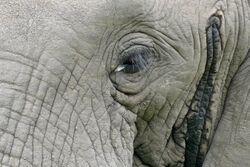
Musth
Observations of adult African bush elephant bulls in Amboseli National Park revealed that they experience a swelling of the temporal glands and a secretion of fluid, the musth fluid, which flows down their cheeks. They begin to dribble urine, initially as discrete drops and later in a regular stream. These manifestations of musth last from a few days to months, depending on the age and condition of the bull. When a bull has been urinating for a long time, the proximal part of the penis and the distal end of the sheath show a greenish coloration, termed the 'green penis syndrome' by Joyce Poole and Cynthia Moss.[36] Males in musth become more aggressive. They guard and mate with females in estrus who stay closer to bulls in musth than to non-musth bulls.[37] Urinary testosterone increases during musth.[38] Bulls begin to experience musth by the age of 24 years. Periods of musth are short and sporadic in young bulls up to 35 years old, lasting a few days to weeks. Older bulls are in musth for 2–5 months every year. Musth occurs mainly during and following the rainy season, and when females are in estrus.[39] Bulls in musth often chase each other and are aggressive towards other bulls in musth. When old and high-ranking bulls in musth threaten and chase young bulls in musth, the latter either leave the group or their musth ceases.[40]

Young bulls in musth killed about 50 white rhinoceros in Pilanesberg National Park between 1992 and 1997. This unusual behavior was attributed to the age and socialisation of the young bulls: they were 17–25 year old orphans remaining from culled families and grew up without the guidance of dominant bulls. When six adult bulls were introduced into the park, the young bulls did not attack rhinos any more. This experience indicates that older bulls suppress musth and aggressiveness of younger bulls.[41][42] Similar incidents were recorded in Hluhluwe-Umfolozi Park, where young bulls killed five black and 58 white rhinoceros between 1991 and 2001. After the introduction of 10 up to 45 year old bulls, the number of rhinos killed by elephants decreased considerably.[43]
Reproduction
Spermatogenesis starts when bulls are about 15 years old.[44] Females ovulate for the first time at the age of 11 years.[45] They are in estrus for 2–6 days.[46] In captivity, cows have an oestrous cycle lasting 14–15 weeks. Foetal gonads enlarge during the second half of pregnancy.[47]
African bush elephants mate during the rainy season.[45] Bulls in musth cover long distances in search for females and associate with large family units. They listen for the females loud, very low frequency calls and attract females by calling and by leaving trails of strong-smelling urine. Females search for bulls in musth, listen for their calls and follow their urine trails.[48] Bulls in musth are more successful at obtaining mating opportunities than non-musth bulls. Females move away from bulls that attempt to test her estrous condition. If pursued by several bulls, they run away. Once they choose their mating partners, they stay away from other bulls that are threatened and chased away by the favoured bull. Competition between bulls overrides their choice sometimes.[46]
Gestation lasts 22 months. Interval between births was estimated at 3.9 to 4.7 years in Wankie National Park.[45] Where hunting pressure on adult elephants was high in the 1970s, cows gave birth once in 2.9 to 3.8 years.[49] Cows in Amboseli National Park gave birth once in five years on average.[46]
The birth of a calf was observed in Tsavo East National Park in October 1990. A group of 80 elephants including eight bulls had gathered in the morning in a 150 m (490 ft) radius around the birth site. A small group of calves and females stood near the pregnant female, rumbling and flapping their ears. One cow seemed to assist her. While in labour, fluid streamed from her temporal and ear canals. She kept standing while giving birth. The newborn calf struggled to its feet within 30 minutes and walked 20 minutes later. The mother expelled the placenta about 100 minutes after birth and covered it with soil immediately.[50] Captive-born calves weigh between 100 and 120 kg (220 and 260 lb) at birth and gain about 0.5 kg (1.1 lb) weight per day.[51] Cows lactate for about 4.8 years.[52] Calves exclusively suckle their mother’s milk during the first three months. Thereafter, they start feeding independently and slowly increase the time spent feeding until they are two years old. During the first three years, male calves spend more time suckling and grow faster than female calves. After this period, cows reject male calves more frequently from their nipples than female calves.[53]
The maximum lifespan of the African bush elephant is between 70 and 75 years.[54] Its generation length is 25 years.[55]
Predators
In Botswana's Chobe National Park, subadult elephants are preyed upon by lions. They attacked and fed on elephants when smaller prey species were scarce. Between 1993 and 1996, lions successfully attacked 74 elephants; 26 were older than nine, and one was a bull of over 15 years. Most were killed at night, and hunts occurred more often during waning moon nights than during bright moon nights.[56] In the same park, lions killed eight elephants in October 2005 that were aged between one and 11 years, two of them older than eight years. Successful hunts took place after dark when prides exceeded 27 lions and herds were smaller than five elephants.[57]
Threats
The African bush elephant is threatened foremost by habitat loss and fragmentation following conversion of natural habitat for livestock farming, plantations of non-timber crops and building of urban and industrial areas. As a result, human-elephant conflict has increased.[2]
Poaching
Poachers target foremost elephant bulls for their tusks, which leads to a skewed sex ratio and affects the survival chances of a population. Access of poachers to unregulated black markets is facilitated by corruption and in periods of civil war in some elephant range countries.[58]
In June 2002, a container packed with more than 6.5 t (6.4 long tons; 7.2 short tons) ivory was confiscated in Singapore. It contained 42,120 hanko stamps and 532 tusks of African bush elephants that originated in Southern Africa, centered in Zambia and neighboring countries. Between 2005 and 2006, a total of 23.461 t (23.090 long tons; 25.861 short tons) ivory plus 91 unweighed tusks of African bush elephants were confiscated in 12 major consignments being shipped to Asia.[59]
When the international ivory trade reopened in 2006, the demand and price for ivory increased in Asia. The African bush elephant population in Chad's Zakouma National Park numbered 3,900 individuals in 2005. Within five years, more than 3,200 elephants were killed. The park did not have sufficient guards to combat poaching, and their weapons were outdated. Well organized networks facilitated smuggling the ivory through Sudan.[60] Poaching also increased in Kenya in those years.[61] In Samburu National Reserve, 41 bulls were illegally killed between 2008 and 2012, equivalent to 31% of the reserve’s elephant population.[62]
These killings were linked to confiscations of ivory and increased prices for ivory on the local black market.[63] About 10,370 tusks were confiscated in Singapore, Hong Kong, Taiwan, Philippines , Thailand, Malaysia, Kenya and Uganda between 2007 and 2013. Genetic analysis of tusk samples showed that they originated from African bush elephants killed in Tanzania, Mozambique, Zambia, Kenya and Uganda. Most of the ivory was smuggled through East African countries.[64]
Between 2003 and 2015, illegal killing of 14,606 African bush elephants was reported by rangers across 29 range countries. Chad is a major transit country for smuggling of ivory in West Africa. This trend was curtailed by raising penalties for poaching and improving law enforcement.[65]
During the 20th century, the African bush elephant population was severely decimated.[66] Poaching of the elephant has dated back all the way to the years of 1970 and 1980, which was considered the largest killings in history. Unfortunately, the species is placed in harm's way due to the limited conservation areas provided in Africa. In most cases, the killings of the African bush elephant have occurred near the outskirts of the protected areas.[2]
In addition to being poached, the carcasses of elephants may get poisoned by the poachers, to avoid detection by vultures which help rangers track poaching activity by circling around dead animals, and pose a threat to those vultures or birds that scavenge on them. On the 20th of June 2019, the carcasses of 468 white-backed vultures, 17 white-headed vultures, 28 hooded vultures, 14 lappet-faced vultures and 10 cape vultures, altogether 537 endangered vultures, besides 2 tawny eagles, were found in northern Botswana. It is suspected that they died after eating the poisoned carcasses of 3 elephants.[67][68][69][70]
Habitat changes
Vast areas in Sub-Saharan Africa were transformed for agricultural use and building of infrastructure. This disturbance leaves the elephants without a stable habitat and limits their ability to roam freely. Large corporations associated with commercial logging and mining have stripped apart the land, giving poachers easy access to the African bush elephant.[71] As human development grows, the human population faces the trouble of contact with the elephants more frequently, due to the species need for food and water. Farmers residing in nearby areas get into conflict with the African bush elephants rummaging through their crops. In many cases, they kill the elephants instantly as they disturb a village or forage upon their crops.[66] Deaths caused by browsing on the invasive alien plant, Cryptostegia grandiflora, has been reported.[72]
Pathogens
Observations at Etosha National Park indicate that African bush elephant die due to anthrax foremost in November at the end of the dry season.[73] Anthrax spores spread through the intestinal tracts of vultures, jackals and hyaenas that feed on the carcasses. Anthrax killed over 100 elephants in Botswana in 2019.[74] It is thought that wild bush elephants can contract fatal tuberculosis from humans.[75] Infection of the vital organs by Citrobacter freundii bacteria has caused the death of an otherwise healthy bush elephant after capture and translocation.[72]
The cause of death of over 400 bush elephants in Botswana's Okavango Delta in 2020 is unknown, but is suspected to be caused by a dangerous neurotoxin. The elephants started dying in April 2020 in the wetland area in the northwest of the country. Calves and adult elephants wander around confused, emaciated and in distress. They collapse when the suspected toxin impairs their motor functions and their legs become paralysed. Poaching, poisoning and anthrax have been excluded as potential causes.[76]
Conservation

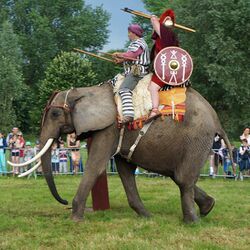
The African bush elephants has been listed on Appendix I of the Convention on International Trade in Endangered Species of Wild Fauna and Flora since 1989. In 1997, Botswana, Namibia and Zimbabwe placed it on Appendix II. So did South Africa in 2000. Community-based conservation programmes have been initiated in several range countries, which contributed to reduce human-elephant conflict and to increase local people's tolerance towards elephants.[2]
In 1986, the African Elephant Database was initiated with the aim to collate and update information on distribution and status of elephant populations in Africa. The database includes results from aerial surveys, dung counts, interviews with local people and data on poaching.[65]
Researchers discovered that playing back the recorded sounds of African bees is an effective method to drive elephants away from settlements.[77]
Status
In 1996, IUCN Red List assessors for the African bush elephant considered the species Endangered. Since 2004, it has been assessed Vulnerable, as the global population was estimated to be increasing at a rate of 4% per year. About 70% of its range is located outside protected areas.[2]
In 2016, the global population was estimated at 415,428 ± 20,111 individuals distributed in a total area of 20,731,202 km2 (8,004,362 sq mi), of which 30% is protected. 42% of the total population lives in nine Southern African countries comprising 293,447 ± 16,682 individuals; Africa's largest population lives in Botswana with 131,626 ± 12,508 individuals.[65]
In captivity
The social behavior of elephants in captivity mimics that of those in the wild. Females are kept with other females, in groups, while males tend to be separated from their mothers at a young age, and are kept apart. According to Schulte, in the 1990s, in North America, a few facilities allowed male interaction. Elsewhere, males were only allowed to smell each other. Males and females were allowed to interact for specific purposes such as breeding. In that event, females were more often moved to the male than the male to the female. Females are more often kept in captivity because they are easier and less expensive to house.[78]
See also
- 2006 Zakouma elephant slaughter
- Elephant cognition
- Dwarf elephant
- Knysna elephants
- Pygmy elephant
References
- ↑ 1.0 1.1 Template:MSW3 Proboscidea
- ↑ 2.0 2.1 2.2 2.3 2.4 2.5 2.6 Blanc, J. (2008). "Loxodonta africana". IUCN Red List of Threatened Species 2008: e.T12392A3339343. https://www.iucnredlist.org/species/12392/3339343.
- ↑ 3.0 3.1 3.2 3.3 Laws, R. M. (1966). "Age criteria for the African elephant: Loxodonta a. africana". African Journal of Ecology 4 (1): 1–37. doi:10.1111/j.1365-2028.1966.tb00878.x.
- ↑ 4.0 4.1 4.2 Larramendi, A. (2016). "Shoulder height, body mass and shape of proboscideans". Acta Palaeontologica Polonica 61 (3): 537–574. doi:10.4202/app.00136.2014. https://www.app.pan.pl/archive/published/app61/app001362014.pdf.
- ↑ Blumenbach, J. F. (1797). "2. Africanus". Handbuch der Naturgeschichte (Fifth ed.). Göttingen: Johann Christian Dieterich. p. 125. http://www.deutschestextarchiv.de/book/view/blumenbach_naturgeschichte_1797?p=147.
- ↑ Cuvier, G. (1824). "Éléphants d’Afrique". Histoire Naturelle des Mammifères, avec des figures originales, coloriées, dessinées d'après des animaux vivans. Tome 6. Paris: A. Belain. pp. 117–118. https://archive.org/details/histoirenaturel6geof/page/n115.
- ↑ Matschie, P. (1900). "Geographische Abarten des Afrikanischen Elefanten". Sitzungsberichte der Gesellschaft Naturforschender Freunde zu Berlin 3: 189–197. https://archive.org/details/sitzungsberichte1900gese/page/196.
- ↑ Lydekker, R. (1907). "The Ears as a Race-Character in the African Elephant". Proceedings of the Zoological Society of London (January to April): 380–403. https://archive.org/details/proceedingsofzoo19071446zool/page/380.
- ↑ Deraniyagala, P. E. P. (1955). Some extinct elephants, their relatives, and the two living species. Colombo: Ceylon National Museums Publication.
- ↑ Rohland, N.; Malaspinas, A. S.; Pollack, J. L.; Slatkin, M.; Matheus, P.; Hofreiter, M. (2007). "Proboscidean mitogenomics: chronology and mode of elephant evolution using mastodon as outgroup". PLOS Biology 5 (8): e207. doi:10.1371/journal.pbio.0050207. PMID 17676977.
- ↑ Rohland, N.; Reich, D.; Mallick, S.; Meyer, M.; Green, R. E.; Georgiadis, N. J.; Roca, A. L.; Hofreiter, M. (2010). "Genomic DNA Sequences from Mastodon and Woolly Mammoth Reveal Deep Speciation of Forest and Savanna Elephants". PLOS Biology 8 (12): e1000564. doi:10.1371/journal.pbio.1000564. PMID 21203580.
- ↑ Jardine, W. (1836). "The Elephant of Africa". The Naturalist's Library. Volume V. Natural History of the Pachydermes, Or, Thick-skinned Quadrupeds. Edinburgh, London, Dublin: W.H. Lizars, Samuel Highley, W. Curry, jun. & Company. pp. 124–132. https://books.google.com/books?id=XyYOAAAAQAAJ&pg=PA124#v=onepage&f=false.
- ↑ 13.0 13.1 Estes, R. D. (1999). "Elephant Loxodonta africana Family Elephantidae, Order Proboscidea". The Safari Companion: A Guide to Watching African Mammals Including Hoofed Mammals, Carnivores, and Primates (Revised and expanded ed.). Vermont: Chelsea Green Publishing Company. p. 223–233. ISBN 1-890132-44-6. https://books.google.com/books?id=Xqp7poFviNcC.
- ↑ 14.0 14.1 Shoshani, J. (1978). "General information on elephants with emphasis on tusks". Elephant 1 (2): 20–31. doi:10.22237/elephant/1491234053. https://digitalcommons.wayne.edu/cgi/viewcontent.cgi?article=1016&context=elephant.
- ↑ Grubb, P.; Groves, C. P.; Dudley, J. P.; Shoshani, J. (2000). "Living African elephants belong to two species: Loxodonta africana (Blumenbach, 1797) and Loxodonta cyclotis (Matschie, 1900)". Elephant 2 (4): 1–4. doi:10.22237/elephant/1521732169.
- ↑ Laws, R. M.; Parker, I. S. C. (1968). "Recent studies on elephant populations in East Africa". Symposia of the Zoological Society of London 21: 319–359.
- ↑ Hanks, J. (1972). "Growth of the African elephant (Loxodonta africana)". East African Wildlife Journal 10 (4): 251–272. doi:10.1111/j.1365-2028.1972.tb00870.x.
- ↑ Laws, R. M.; Parker, I. S. C.; Johnstone, R. C. B. (1975). Elephants and Their Habitats: The Ecology of Elephants in North Bunyoro, Uganda. Oxford, the United Kingdom: Clarendon Press.
- ↑ Laurson, B.; Bekoff, M. (1978). "Loxodonta africana". Mammalian Species (92): 1–8. doi:10.2307/3503889.
- ↑ Kock, N. D.; Goedegebuure, S. A.; Lane, E. P.; Lucke, V.; Tyrrel l, D.; Kock, M. D. (1994). "Flaccid Trunk Paralysis in Free-ranging Elephants (Loxodonta africana) in Zimbabwe". Journal of Wildlife Diseases 30 (3): 432–435. doi:10.7589/0090-3558-30.3.432. PMID 7933290.
- ↑ Raubenheimer, E. J.; Van Heerden, W. F. P.; Van Niekerk, P. J.; De Vos, V.; Turner, M. J. (1995). "Morphology of the deciduous tusk (tush) of the African elephant (Loxodonta africana)". Archives of Oral Biology 40 (6): 571–576. doi:10.1016/0003-9969(95)00008-D. PMID 7677604. https://repository.up.ac.za/bitstream/handle/2263/28439/Complete.pdf?sequence=10#page=135.
- ↑ Shoshani, J. (1996). "Skeletal and other basic anatomical features of elephants". The Proboscidea: Evolution and Palaeoecology of Elephants and Their Relatives. New York: Oxford University Press. pp. 9–20.
- ↑ Raubenheimer, E. J.; Bosman, M. C.; Vorster, R.; Noffke, C. E. (1998). "Histogenesis of the chequered pattern of ivory of the African elephant (Loxodonta africana)". Archives of Oral Biology 43 (12): 969–977. doi:10.1016/S0003-9969(98)00077-6. PMID 9877328.
- ↑ Jachmann, H. (1988). "Estimating age in African elephants: a revision of Laws' molar evaluation technique". African Journal of Ecology 22 (1): 51–56. doi:10.1111/j.1365-2028.1988.tb01127.x.
- ↑ Yalden, D. W.; Largen, M. J.; Kock, D. (1986). "Catalogue of the Mammals of Ethiopia. 6. Perissodactyla, Proboscidea, Hyracoidea, Lagomorpha, Tubulidentata, Sirenia, and Cetacea". Monitore Zoologico Italiano Supplemento 21 (1): 31–103. doi:10.1080/03749444.1986.10736707.
- ↑ 26.0 26.1 Douglas-Hamilton, I. (1972). On the ecology and behaviour of the African elephant: the elephants of Lake Manyara (PhD thesis). Oxford: University of Oxford.
- ↑ Douglas-Hamilton, I. (1973). "On the ecology and behaviour of the Lake Manyara elephants". East African Wildlife Journal 11 (3–4): 401–403. doi:10.1111/j.1365-2028.1973.tb00101.x.
- ↑ Leuthold, W. (1976). "Group size in elephants of Tsavo National Park and possible factors influencing it". Journal of Animal Ecology 45 (2): 425–439. doi:10.2307/3883.
- ↑ Eltringham, S. K. (1977). "The numbers and distribution of elephant Loxodonta africana in the Rwenzori National Park and Chambura Game Reserve, Uganda". African Journal of Ecology 15 (1): 19–39. doi:10.1111/j.1365-2028.1977.tb00375.x.
- ↑ Moss, C. J.; Poole, J. H. (1983). "Relationships and social structure of African elephants". Primate Social Relationships: An Integrated Approach. Oxford: Blackwell. pp. 315–325.
- ↑ Bax, P. N.; Sheldrick, D. L. W. (1963). "Some preliminary observations on the food of elephant in the Tsavo Royal National Park (East) of Kenya". African Journal of Ecology 1 (1): 40–51. doi:10.1111/j.1365-2028.1963.tb00177.x.
- ↑ Biru, Y.; Bekele, A. (2012). "Food habits of African elephant (Loxodonta africana) in Babile Elephant Sanctuary, Ethiopia". Tropical Ecology 53 (1): 43–52. https://www.researchgate.net/publication/267715070.
- ↑ Ruggiero, R. G. & Fay, J. M. (1994). "Utilization of termitarium soils by elephants and its ecological implications". African Journal of Ecology 32 (3): 222–232. doi:10.1111/j.1365-2028.1994.tb00573.x.
- ↑ Weir, J. S. (1969). "Chemical properties and occurrence on Kalahari sand of salt licks created by elephants". Journal of Zoology 158 (3): 293–310. doi:10.1111/j.1469-7998.1969.tb02148.x.
- ↑ Weir, J. S. (1972). "Spatial distribution of Elephants in an African National Park in relation to environmental sodium". Oikos 23 (1): 1–13. doi:10.2307/3543921.
- ↑ Poole, J. H.; Moss, C. J. (1981). "Musth in the African elephant, Loxodonta africana". Nature 292 (5826): 830–831. doi:10.1038/292830a0. PMID 7266649. Bibcode: 1981Natur.292..830P.
- ↑ Poole, J. H. (1982). Musth and male-male competition in the African elephant (PhD thesis). Cambridge: University of Cambridge.
- ↑ Poole, J. H.; Kasman, L. H.; Ramsay, E. C.; Lasley, B. L. (1984). "Musth and urinary testosterone concentrations in the African elephant (Loxodonta africana)". Reproduction 70 (1): 255–260. doi:10.1530/jrf.0.0700255. PMID 6694143.
- ↑ Poole, J. H. (1987). "Rutting behavior in African elephants: the phenomenon of musth". Behaviour 102 (3–4): 283–316. doi:10.1163/156853986X00171.
- ↑ Poole, J. H. (1989). "Announcing intent: the aggressive state of musth in African elephants". Animal Behaviour 37 (37): 140–152. doi:10.1016/0003-3472(89)90014-6. https://www.kotafoundation.org/wp-content/uploads/2016/02/Poole1989AggressiveStateofMusth.pdf.
- ↑ Slotow, R.; van Dyk, G.; Poole, J.; Page, B.; Klocke, A. (2000). "Older bull elephants control young males". Nature 408 (6811): 425–426. doi:10.1038/35044191. PMID 11100713. Bibcode: 2000Natur.408..425S.
- ↑ Slotow, R.; van Dyk, G. (2001). "Role of delinquent young 'orphan' male elephants in high mortality of white rhinoceros in Pilanesberg National Park, South Africa". Koedoe (44): 85–94. http://koedoe.co.za/index.php/koedoe/article/download/188/172.
- ↑ Slotow, R.; Balfour, D.; Howison, O. (2001). "Killing of black and white rhinoceroses by African elephants in Hluhluwe-Umfolozi Park, South Africa". Pachyderm (31): 14–20. http://www.iucn.org/themes/ssc/sgs/afesg/pachy/pdfs/pachy31.pdf.
- ↑ Hanks, J. (1973). "Reproduction in the male African elephant in the Luangwa Valley, Zambia". South African Journal of Wildlife Research 3 (2): 31–39. https://journals.co.za/content/wild/3/2/AJA03794369_2812?crawler=true&mimetype=application/pdf.
- ↑ 45.0 45.1 45.2 Williamson, B. R. (1976). "Reproduction in female African elephant in the Wankie National Park, Rhodesia". South African Journal of Wildlife Research 6 (2): 89–93. https://journals.co.za/content/wild/6/2/AJA03794369_3213?crawler=true&mimetype=application/pdf.
- ↑ 46.0 46.1 46.2 Moss, C. J. (1983). "Oestrous behaviour and female choice in the African elephant". Behaviour 86 (3/4): 167–196. doi:10.1163/156853983X00354.
- ↑ Allen, W. (2006). "Ovulation, Pregnancy, Placentation and Husbandry in the African Elephant (Loxodonta africana)". Philosophical Transactions: Biological Sciences 361 (1469): 821–834. doi:10.1098/rstb.2006.1831. PMID 16627297.
- ↑ Poole, J. H.; Moss, C. J. (1989). "Elephant mate searching: group dynamics and vocal and olfactory communication". The Biology of Large African Mammals in Their Environment. Symposia of the Zoological Society of London. 61. London: Clarendon Press. pp. 111–125.
- ↑ Kerr, M. A. (1978). "Reproduction of elephant in the Mana Pools National Park, Rhodesia". Arnoldia (Rhodesia) 8 (29): 1–11.
- ↑ McKnight, B. L. (1992). "Birth of an African elephant in Tsavo East National Park, Kenya". African Journal of Ecology 30 (1): 87–89. doi:10.1111/j.1365-2028.1992.tb00481.x.
- ↑ Lang, E. M. (1967). "The birth of an African elephant Loxodonta africana at Basle Zoo". International Zoo Yearbook 7 (1): 154–157. doi:10.1111/j.1748-1090.1967.tb00359.x.
- ↑ Smith, N. S.; Buss, I. O. (1973). "Reproductive ecology of the female African elephant". The Journal of Wildlife Management 37 (4): 524–534. doi:10.2307/3800318.
- ↑ Lee, P. C.; Moss, C. J. (1986). "Early maternal investment in male and female African elephant calves". Behavioral Ecology and Sociobiology 18 (5): 353–361. doi:10.1007/BF00299666. https://www.researchgate.net/publication/225904541.
- ↑ Lee, P. C.; Sayialel, S.; Lindsay, W. K.; Moss, C. J. (2012). "African elephant age determination from teeth: validation from known individuals". African Journal of Ecology 50 (1): 9–20. doi:10.1111/j.1365-2028.2011.01286.x.
- ↑ Pacifici, M.; Santini, L.; Di Marco, M.; Baisero, D.; Francucci, L.; Grottolo Marasini, G.; Visconti, P.; Rondinini, C. (2013). "Generation length for mammals". Nature Conservation 5 (5): 87–94. doi:10.3897/natureconservation.5.5734.
- ↑ Joubert, D. (2006). "Hunting behaviour of lions (Panthera leo) on elephants (Loxodonta africana) in the Chobe National Park, Botswana". African Journal of Ecology 44 (2): 279–281. doi:10.1111/j.1365-2028.2006.00626.x.
- ↑ Power, R. J.; Compion, R. X. S. (2009). "Lion predation on elephants in the Savuti, Chobe National Park, Botswana". African Zoology 44 (1): 36–44. doi:10.3377/004.044.0104. https://www.researchgate.net/publication/232693088.
- ↑ Lemieux, A. M.; Clarke, R. V. (2009). "The international ban on ivory sales and its effects on elephant poaching in Africa". The British Journal of Criminology 49 (4): 451–471. doi:10.1093/bjc/azp030.
- ↑ Wasser, S. K.; Mailand, C.; Booth, R.; Mutayoba, B.; Kisamo, E.; Clark, B.; Stephens, M. (2007). "Using DNA to track the origin of the largest ivory seizure since the 1989 trade ban". Proceedings of the National Academy of Sciences 104 (10): 4228–4233. doi:10.1073/pnas.0609714104. PMID 17360505.
- ↑ Poilecot, P. (2010). "Le braconnage et la population d'éléphants au Parc National de Zakouma (Tchad)". Bois et Forêts des Tropiques 303 (303): 93–102. doi:10.19182/bft2010.303.a20454. https://www.researchgate.net/publication/291781119.
- ↑ Douglas-Hamilton, I. (2009). "The current elephant poaching trend". Pachyderm (45): 154–157. http://savetheelephants.org/wp-content/uploads/2016/11/2009ElephantPoachingTrendSWARA.pdf.
- ↑ Wittemyer, G.; Daballen, D.; Douglas-Hamilton, I. (2013). "Comparative Demography of an At-Risk African Elephant Population". PLOS ONE 8 (1): e53726. doi:10.1371/journal.pone.0053726. PMID 23341984. Bibcode: 2013PLoSO...853726W.
- ↑ Wittemyer, G.; Northrup, J. M.; Blanc, J.; Douglas-Hamilton, I.; Omondi, P.; Burnham, K. P. (2014). "Illegal killing for ivory drives global decline in African elephants". Proceedings of the National Academy of Sciences 111 (36): 13117–13121. doi:10.1073/pnas.1403984111. PMID 25136107. Bibcode: 2014PNAS..11113117W.
- ↑ Wasser, S. K.; Brown, L.; Mailand, C.; Mondol, S.; Clark, W.; Laurie, C.; Weir, B. S. (2015). "Genetic assignment of large seizures of elephant ivory reveals Africa's major poaching hotspots". Science 349 (6243): 84–87. doi:10.1126/science.aaa2457. PMID 26089357. Bibcode: 2015Sci...349...84W.
- ↑ 65.0 65.1 65.2 Thouless, C. R.; Dublin, H. T.; Blanc, J. J.; Skinner, D. P.; Daniel, T. E.; Taylor, R. D.; Maisels, F.; Frederick, H. L. et al. (2016). African Elephant Status Report 2016 : an update from the African Elephant Database. Occasional Paper of the IUCN Species Survival Commission No. 60. Gland: IUCN SSC African Elephant Specialist Group. ISBN 978-2-8317-1813-2. https://www.dropbox.com/s/7a8w3kk6r9hzm0r/AfESG%20African%20Elephant%20Status%20Report%202016.pdf?dl=1.
- ↑ 66.0 66.1 Ceballos, G.; Ehrlich, A. H.; Ehrlich, P. R. (2015). The Annihilation of Nature: Human Extinction of Birds and Mammals. Baltimore, Maryland: Johns Hopkins University Press. pp. 102. ISBN:1421417189.
- ↑ "Over 500 Rare Vultures Die After Eating Poisoned Elephants In Botswana". Agence France-Press (NDTV). 2019-06-21. https://www.ndtv.com/world-news/over-500-rare-vultures-die-after-eating-poisoned-elephants-in-botswana-2056740.
- ↑ Hurworth, Ella (2019-06-24). "More than 500 endangered vultures die after eating poisoned elephant carcasses". CNN. https://edition.cnn.com/2019/06/21/africa/botswana-vultures-endangered-elephants-intl-hnk/index.html.
- ↑ Solly, Meilan (2019-06-24). "Poachers' Poison Kills 530 Endangered Vultures in Botswana". Smithsonian. https://www.smithsonianmag.com/smart-news/poachers-poison-kills-530-endangered-vultures-botswana-180972477/.
- ↑ Ngounou, Boris (2019-06-27). "BOTSWANA: Over 500 vultures found dead after massive poisoning". Afrik21. https://www.afrik21.africa/en/botswana-over-500-vultures-found-dead-after-massive-poisoning/.
- ↑ "Facts About African Elephants - The Maryland Zoo in Baltimore". The Maryland Zoo in Baltimore. http://www.marylandzoo.org/animals-conservation/elephant-program/facts-about-african-elephants/.
- ↑ 72.0 72.1 Ortega, Joaquín; Corpa, Juan M.; Orden, José A.; Blanco, Jorge; Carbonell, María D.; Gerique, Amalia C.; Latimer, Erin; Hayward, Gary S. et al. (15 July 2015). "Acute death associated with Citrobacter freundii infection in an African elephant (Loxodonta africana)". Journal of Veterinary Diagnostic Investigation 27 (5): 632–636. doi:10.1177/1040638715596034. https://journals.sagepub.com/doi/pdf/10.1177/1040638715596034. Retrieved 12 July 2020.
- ↑ Lindeque, P. M.; Turnbull, P. C. (1994). "Ecology and epidemiology of anthrax in the Etosha National Park, Namibia". The Onderstepoort Journal of Veterinary Research 61 (1): 71–83. PMID 7898901. https://pubmed.ncbi.nlm.nih.gov/7898901/.
- ↑ "Botswana: Lab tests to solve mystery of hundreds of dead elephants". BBC. 2020. https://www.bbc.com/news/world-africa-53273361. Retrieved 3 July 2020.
- ↑ Miller, M.A.; Buss, P.; Roos, E.O.; Hausler, G.; Dippenaar, A.; Mitchell, E.; van Schalkwyk, L.; Robbe-Austerman, S. et al. (2019). "Fatal Tuberculosis in a Free-Ranging African Elephant and One Health Implications of Human Pathogens in Wildlife". Frontiers in Veterinary Science 6: 18. doi:10.3389/fvets.2019.00018. PMID 30788347. https://pubmed.ncbi.nlm.nih.gov/30788347/.
- ↑ Brown, W. (2020). "Nerve agent fear as hundreds of elephants perish mysteriously in Botswana". The Telegraph. https://news.yahoo.com/hundreds-elephants-die-mysteriously-botswana-160803566.html. Retrieved 3 July 2020.
- ↑ King, L. E.; Douglas-Hamilton, I.; Vollrath, F. (2007). "African elephants run from the sound of disturbed bees". Current Biology 17 (19): R832–R833. doi:10.1016/j.cub.2007.07.038. PMID 17925207.
- ↑ Schulte, B. A. (2000). "Social structure and helping behavior in captive elephants". Zoo Biology 19 (5): 447–459. doi:10.1002/1098-2361(2000)19:5<447::aid-zoo12>3.0.co;2-#. https://www.researchgate.net/publication/230242723.
Further reading
- Caitlin O'Connell (2015). Elephant Don: The Politics of a Pachyderm Posse. University of Chicago Press. ISBN 978-0226106113. https://archive.org/details/elephantdonpolit0000ocon.
External links
- Elephant Information Repository – An in-depth resource on elephants
- ARKive – images and movies of the African Bush Elephant (Loxodonta africana)
- BBC Wildlife Finder – Clips from the BBC archive, news stories and sound files of the African Bush Elephant
- View the elephant genome on Ensembl
- People Not Poaching: The Communities and IWT Learning Platform
- Handwerk, B. (2006). "African Elephants Slaughtered in Herds Near Chad Wildlife Park". National Geographic. Archived from the original on 1 September 2006. https://web.archive.org/web/20060901103227/http://news.nationalgeographic.com/news/2006/08/060830-elephants-chad.html. Retrieved 1 September 2006.
Wikidata ☰ Q36557 entry

